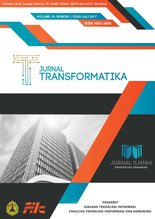Evaluasi Perancangan Antarmuka untuk Membangun User Experience pada Layanan SInTA Universitas Kristen Duta Wacana Yogyakarta
DOI:
https://doi.org/10.26623/transformatika.v15i1.458Keywords:
mesin pencari, user experience, search experience, usability testing, individual expert reviewAbstract
SInTA is a search engine developed by Duta Wacana Christian University (DWCU) to locate references of final task reports or thesis ever made by DWCU students.The existence and function of SInTA is not widely known by students. In addition, SInTA still require many improvements on feature and UI design to simplify the interaction between users and interface.This research use individual expert review approach to evaluate interface, whereas data divided into 6 User Experience measurement scales. The result of evaluation is User Experience recommendation which used to build prototype.Considering User Experience shall be created a prototype which should attract users, meet the needs of users, and satisfy the users. In this research, prototype has higher User Experience mean values rather than SInTA old interface, thereby the research be assessed as being successful.References
Arikunto, S. (2010). Prosedur Penelitian: Suatu Pendekatan
Praktik. Jakarta: Rineka Cipta.
Chapman, C. (2010). Better UI Design: Proper Use of Tables.
Diakses 10 Maret 2015, dari http://www.noupe.com/design/better-
ui-design-proper-use-of-tables.html.
Eka, R. (2013). Bab 6: Deviasi, Range, Varian. Diakses 20 April
, dari http://radityaeka5.blogspot.com/2013/10/bab
defiasirangevarian.html.
Garoufallou, E. (2012). Evaluating search engine: a comparative
study between international and greek SE by greek librarians.
Researchgate, 46(2), 182-198.
Garrett, J. J. (2011). The Elements of User Experience: User-
Centered Design for the Web and Beyond (2nd ed.). M. J. Nolan,
R. Weisburd,T. Croom, & D. Adrianson (Eds.). Berkeley, CA: New
Riders.
Gliem, J.A. & Gliem, R.R. (2003). Calculating, interpreting, and
reporting Cronbach s alpha reliability coefficient for likert-type
scales. 2003 Midwest Research to Practice Conference in Adult,
Continuing, and Community Education (pp. 82-88).
Haryanto, D. (2013). Fungsi Counta pada Excel. Diakses 20 April
, dari http://trikmicrosoftexcel.blogspot.com/2013/06/fungsi-
counta-pada-excel.html.
Jarrett, K. (2012). Findit@Flinders: user experience of the Primo
discovery search solution. Australian Academy and Research
Libraries, 43(4), 278-299.
Laugwitz, B. et al (2008). Construction and evaluation of a User
Experience Questionnaire. In A. Holzinger (Ed.), HCI and Usability
for Education and Work (pp. 63-76). Berlin, Heidelberg, Germany:
Springer.
Nielsen, J. (2012). Usability 101: Introduction to Usability. Diakses
September 2014, dari http://www.nngroup.com/articles/usabi
lity-101-introduction-to-usability/.
Palmquist, R. & Kyung-Sun, K. (2000). Cognitive style and on-line
database search experience as predictors of web search
performance. Journal of the American Society for Information
Science, 51(6), 558-
Pamental, J. (2014). A More Modern Scale for Web Typography.
Diakses 10 Maret 2015, dari http://typecast.com/blog/a-more
modern-scale-for-web-typography.
Proboyekti, U. (2011). SInTA-Sistem Informasi Tugas Akhir.
Diakses 16 Mei 2015, dari http://sambungjaring.blogspot.
co.id/2011/01/sinta-sistem-informasi-tugas-akhir.html.
Rauschenberger, M. et al (2013). Efficient measurement of the
user experience of interactive products: how to use the User
Experience Questionnaire. International Journal of Interactive
Multimedia and Artificial Intelligence, 2(1), 39-45.
Rubin, J. & Chisnell, D. (2008). Handbook of Usability Testing:
How to Plan, Design, and Conduct Effective Tests (2nd ed.).
Canada: Wiley Publishing.
Russel, T. & Tate, T. (2013). Designing the Search Experience:
The Information Architecture of Discovery. M. Dunkerley & H.
Scherer (Eds.). USA: Elsevier.
Sauro, J. & Lewis, J. R. (2012). Quantifying the User Experience:
Practical Statistics for User Research. S. Eliot & D. Bevans (Eds.).
USA: Elsevier.
Sugiono, D. et al (2008). Kamus Besar Bahasa Indonesia Pusat
Bahasa (ed. IV). Jakarta: Gramedia Pustaka Utama.
Tullis, T. & Albert, B. (2008). Measuring the User Experience:
Collecting, Analyzing, and Presenting Usability Metrics. USA:
Elsevier.
Wilson, C. (2014). User Interface Inspection Methods: A User-
Centered Design Method. M. Dunkerley & H. Scherer (Eds.). USA:
Elsevier.
Arikunto, S. (2010). Prosedur Penelitian: Suatu Pendekatan
Praktik. Jakarta: Rineka Cipta.
Downloads
Published
Issue
Section
License
Authors who publish with this journal agree to the following terms:
- Authors retain copyright and grant the journal right of first publication with the work simultaneously licensed under a Creative Commons Attribution License that allows others to share the work with an acknowledgement of the work's authorship and initial publication in this journal.
- Authors are able to enter into separate, additional contractual arrangements for the non-exclusive distribution of the journal's published version of the work (e.g., post it to an institutional repository or publish it in a book), with an acknowledgement of its initial publication in this journal.
- Authors are permitted and encouraged to post their work online (e.g., in institutional repositories or on their website) prior to and during the submission process, as it can lead to productive exchanges, as well as earlier and greater citation of published work.

Transformatika is licensed under a Creative Commons Attribution 4.0 International License.


